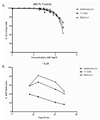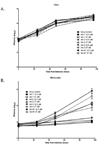Inhibition of heat-shock protein 90 reduces Ebola virus replication
- PMID: 20452380
- PMCID: PMC2907434
- DOI: 10.1016/j.antiviral.2010.04.015
Inhibition of heat-shock protein 90 reduces Ebola virus replication
Abstract
Ebola virus (EBOV), a negative-sense RNA virus in the family Filoviridae, is known to cause severe hemorrhagic fever in humans and other primates. Infection with EBOV causes a high mortality rate and currently there is no FDA-licensed vaccine or therapeutic treatment available. Recently, heat-shock protein 90 (Hsp90), a molecular chaperone, was shown to be an important host factor for the replication of several negative-strand viruses. We tested the effect of several different Hsp90 inhibitors including geldanamycin, radicicol, and 17-allylamino-17-demethoxygeldanamycin (17-AAG; a geldanamycin analog) on the replication of Zaire EBOV. Our results showed that inhibition of Hsp90 significantly reduced the replication of EBOV. Classic Hsp90 inhibitors reduced viral replication with an effective concentration at 50% (EC(50)) in the high nanomolar to low micromolar range, while drugs from a new class of Hsp90 inhibitors showed markedly more potent inhibition. These compounds blocked EBOV replication with an EC(50) in the low nanomolar range and showed significant potency in blocking replication in primary human monocytes. These results validated that Hsp90 is an important host factor for the replication of filoviruses and suggest that Hsp90 inhibitors may be therapeutically effective in treating EBOV infection.
Copyright 2010 Elsevier B.V. All rights reserved.
Figures






Similar articles
-
Antiviral activity and RNA polymerase degradation following Hsp90 inhibition in a range of negative strand viruses.Virology. 2007 May 25;362(1):109-19. doi: 10.1016/j.virol.2006.12.026. Epub 2007 Jan 26. Virology. 2007. PMID: 17258257 Free PMC article.
-
Heat shock protein 90: role in enterovirus 71 entry and assembly and potential target for therapy.PLoS One. 2013 Oct 2;8(10):e77133. doi: 10.1371/journal.pone.0077133. eCollection 2013. PLoS One. 2013. PMID: 24098578 Free PMC article.
-
The effects of heat shock protein 90 inhibitors on apoptosis and viral replication in primary effusion lymphoma cells.Biol Pharm Bull. 2012;35(5):725-30. doi: 10.1248/bpb.35.725. Biol Pharm Bull. 2012. PMID: 22687408
-
Geldanamycin, radicicol, and chimeric inhibitors of the Hsp90 N-terminal ATP binding site.Curr Top Med Chem. 2006;6(11):1173-82. doi: 10.2174/156802606777812031. Curr Top Med Chem. 2006. PMID: 16842154 Review.
-
Discovery and development of heat shock protein 90 inhibitors as anticancer agents: a review of patented potent geldanamycin derivatives.Expert Opin Ther Pat. 2013 Aug;23(8):919-43. doi: 10.1517/13543776.2013.780597. Epub 2013 May 4. Expert Opin Ther Pat. 2013. PMID: 23641970 Review.
Cited by
-
Polyamines and Hypusination Are Required for Ebolavirus Gene Expression and Replication.mBio. 2016 Jul 26;7(4):e00882-16. doi: 10.1128/mBio.00882-16. mBio. 2016. PMID: 27460797 Free PMC article.
-
Advances in Designing and Developing Vaccines, Drugs, and Therapies to Counter Ebola Virus.Front Immunol. 2018 Aug 10;9:1803. doi: 10.3389/fimmu.2018.01803. eCollection 2018. Front Immunol. 2018. PMID: 30147687 Free PMC article. Review.
-
Identification of Ebola Virus Inhibitors Targeting GP2 Using Principles of Molecular Mimicry.J Virol. 2019 Jul 17;93(15):e00676-19. doi: 10.1128/JVI.00676-19. Print 2019 Aug 1. J Virol. 2019. PMID: 31092576 Free PMC article.
-
Inhibition of HSP90 attenuates porcine reproductive and respiratory syndrome virus production in vitro.Virol J. 2014 Feb 3;11:17. doi: 10.1186/1743-422X-11-17. Virol J. 2014. PMID: 24490822 Free PMC article.
-
Theiler's murine encephalomyelitis virus infection induces a redistribution of heat shock proteins 70 and 90 in BHK-21 cells, and is inhibited by novobiocin and geldanamycin.Cell Stress Chaperones. 2011 Sep;16(5):505-15. doi: 10.1007/s12192-011-0262-x. Epub 2011 Mar 29. Cell Stress Chaperones. 2011. PMID: 21445704 Free PMC article.
References
-
- Banerji U. Heat shock protein 90 as a drug target: some like it hot. Clin Cancer Res. 2009;15(1):9–14. - PubMed
-
- Barta TE, Veal JM, Rice JW, Partridge JM, Fadden RP, Ma W, Jenks M, Geng L, Hanson GJ, Huang KH, Barabasz AF, Foley BE, Otto J, Hall SE. Discovery of benzamide tetrahydro-4H-carbazol-4-ones as novel small molecule inhibitors of Hsp90. Bioorg Med Chem Lett. 2008;18(12):3517–3521. - PubMed
-
- Chase G, Deng T, Fodor E, Leung BW, Mayer D, Schwemmle M, Brownlee G. Hsp90 inhibitors reduce influenza virus replication in cell culture. Virology. 2008;377(2):431–439. - PubMed
-
- Clevenger RC, Blagg BS. Design, synthesis, and evaluation of a radicicol and geldanamycin chimera, radamide. Org Lett. 2004;6(24):4459–4462. - PubMed
Publication types
MeSH terms
Substances
Grants and funding
LinkOut - more resources
Full Text Sources
Medical

